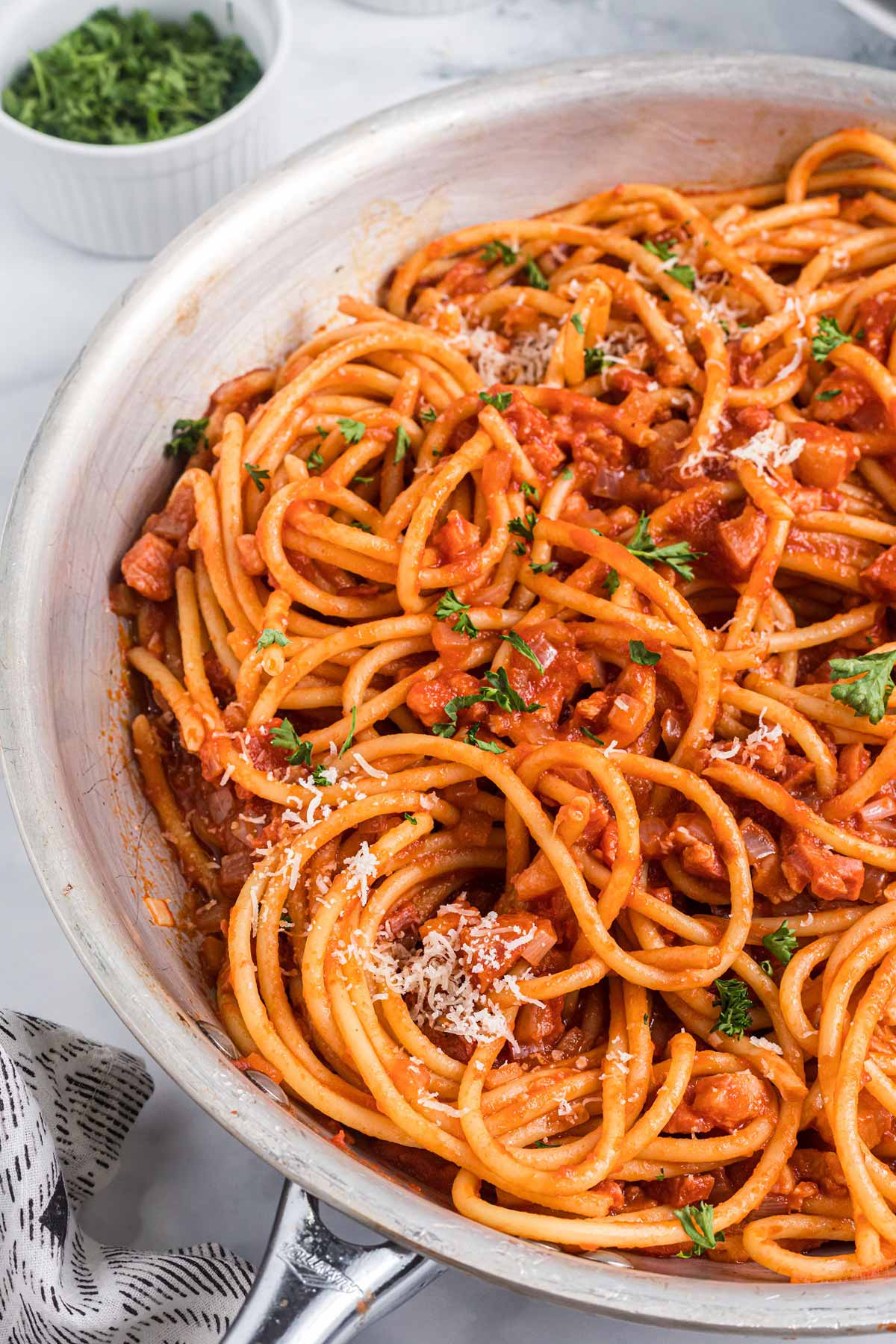Bucatini Allamatriciana: Discover the History and Flavor
Bucatini All’Amatriciana, a celebrated Italian pasta dish, originates from Amatrice, a town in the Lazio region of Italy. The name “All’Amatriciana” directly refers to its birthplace. This dish traces back to the late 18th century when it began as a simpler concoction known as “Gricia.” Shepherds in the region would prepare this meal using ingredients like guanciale (cured pork cheek), pecorino cheese, and black pepper. Tomato, a later addition in the 19th century, transformed Gricia into the rich and flavorful Amatriciana sauce known today. This historical progression highlights the dish’s evolution from peasant fare to a beloved Italian classic.
Key Ingredients
Bucatini All’Amatriciana features a few quintessential ingredients, each contributing to its distinctive taste. The primary ingredient, guanciale, imparts a rich, savory flavor. Pecorino Romano, a salty, tangy sheep’s milk cheese, balances the guanciale’s fat. Tomatoes, preferably San Marzano variety, provide a robust, slightly sweet base. Bucatini, a hollow, tube-like pasta, captures the sauce effectively, ensuring each bite is flavorful. Finally, chili peppers add subtle heat, enhancing the overall taste without overpowering other components. These key ingredients together create a harmonious blend, defining the unique character of Bucatini All’Amatriciana.
Culinary Techniques for Bucatini All’Amatriciana
Cooking the Perfect Bucatini
Cook bucatini pasta to achieve the ideal texture. Use a large pot with 4 to 6 quarts of water and add 1 to 2 tablespoons of salt. Boil the water before adding 1 pound of bucatini. Stir occasionally to prevent sticking. Cook for 8 to 10 minutes, following package instructions until al dente, meaning tender yet firm. Drain the pasta and retain 1 cup of pasta water for later use, ensuring the sauce reaches the desired consistency.
Preparing the Amatriciana Sauce
Create the Amatriciana sauce by following these essential steps. Start by slicing 4 ounces of guanciale into small strips. Heat a pan over medium heat and add the guanciale, cooking until it’s crispy and releases fat, approximately 5 to 7 minutes. Incorporate 1 teaspoon of chili flakes, stirring for an additional minute. Add 28 ounces of San Marzano tomatoes, crushing them by hand or with a spoon. Simmer the mixture for 10 to 15 minutes, allowing flavors to meld. Add the reserved pasta water if the sauce needs thinning. Mix the cooked bucatini into the sauce, ensuring each strand is well-coated. Finish with freshly grated pecorino Romano cheese to enrich the flavor and enhance the dish’s authenticity.
Taste and Texture Profile
What Makes It Unique?
Bucatini All’Amatriciana stands out for its rich, robust flavor and unique texture. The primary ingredient, guanciale, imparts a savory, slightly sweet taste, deepened by its cured pork fat. The San Marzano tomatoes add a tangy sweetness, balancing the richness of the meat. Pecorino Romano cheese, sharp and salty, enhances the savory profile, while chili flakes provide a touch of heat.
The bucatini pasta plays a crucial role, its hollow center ensuring every bite is filled with sauce. Unlike other pasta, bucatini’s thicker structure retains a firm, chewy texture even when fully cooked. This contrast between the tender sauce-coated surface and the pasta’s al dente core creates an engaging mouthfeel. Each ingredient layers distinct flavors, offering a multidimensional experience.
Pairing Suggestions
To complement Bucatini All’Amatriciana, consider robust wines and crisp salads. Chianti or Montepulciano wines, with their acidity and tannins, cut through the dish’s richness, providing a balanced sip. Light, dry white wines like Vermentino offer a refreshing contrast.
For a lighter accompaniment, a simple arugula salad tossed with lemon vinaigrette adds a zesty counterpoint. The peppery greens contrast nicely with the hearty pasta. Garlic bread with a crisp crust and soft interior provides a satisfying textural complement and mops up extra sauce.
Incorporate these pairings to elevate your Bucatini All’Amatriciana experience, bringing harmony to your meal.
Serving and Presentation Tips
Traditional Serving Styles
Serve Bucatini All’Amatriciana in a shallow, wide-rimmed pasta bowl to allow for easy twirling of the bucatini. Sprinkle grated pecorino Romano cheese generously over the pasta to enhance its savory flavor. Garnish with fresh basil or parsley to add a touch of color. Pair it with crusty Italian bread to absorb the flavorful sauce left in the bowl. Use a family-style serving method if sharing with others, placing a large platter of the pasta at the table’s center so everyone can serve themselves.
Modern Twists on Presentation
Present Bucatini All’Amatriciana in a clear glass bowl to showcase the vibrant red color of the sauce. Stack the bucatini into a decorative nest on each plate and drizzle with a high-quality olive oil for added richness. Add microgreens or edible flowers for a modern touch that contrasts with the rich sauce. You could also serve individual portions in mini cast-iron skillets, giving a rustic, gourmet look. Enhance the dish’s visual appeal by placing it on a slate or wooden board, accompanied by small bowls of extra cheese, chili flakes, and olive oil for interactive dining.
Conclusion
Bucatini All’Amatriciana isn’t just a dish; it’s a celebration of Italian culinary tradition. By mastering the balance of its key ingredients and perfecting the preparation techniques, you can recreate this classic at home. Whether you choose traditional serving methods or modern twists, this dish promises a rich, satisfying experience. Pair it with robust wines, crisp salads, and crusty bread to elevate your meal. Enjoy the flavors and textures that make Bucatini All’Amatriciana a timeless favorite.






